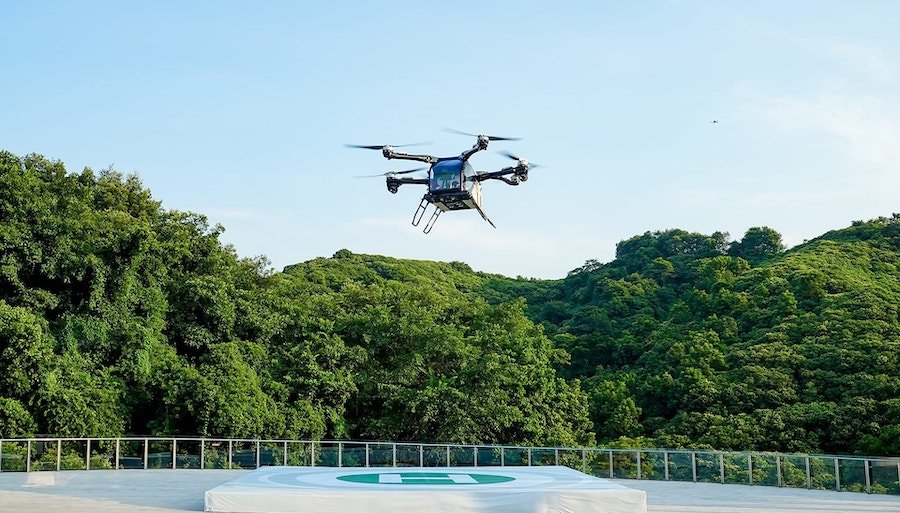Cyber-Mech VTOL Can Be Flown by Anyone in Just 5 Minutes, Comes With Its Own Carrier Van

The concept has been in the news for a while now, but it only exploded into public conscience in January, at the Consumer Electronics Show (CES) in Las Vegas, when the Chinese company, which describes itself as "the largest flying car company in Asia," really spilled the beans on the project.
The concept of a flying car has been around for ages, but all of the designs imagined so far relied on a single vehicle that could be driven on the road and later taken to the sky. The Chinese proposal is a bit different, as it involves a land vehicle and an aircraft in a single package.
The Land Aircraft Carrier (aka Modular Flying Car, Low-Altitude Air Mobility Explorer, or X3-F) has been imagined first and foremost as the "first modular flying car to be mass-produced for individuals." That means it will be sold to people who like to travel the great outdoors and, once on location, can use the flying module to explore their surroundings in an entirely new way.
The ground module of the Carrier is basically a van with a "minimalist, cyber-mech design." It measures 5.5 meters in length, 2 meters in width, and 2 meters in height (18 feet x 6.5 feet x 6.5 feet), meaning it could easily fit inside a standard parking spot.
The van can be driven with a standard license, despite the fact that it is a six-wheeler. It's an all-wheel-drive machine that comes with rear-wheel steering. The vehicle is electric (but also uses a range extender), and relies on the "world’s first 800V silicon carbide extended-range powertrain" that should allow it to drive for up to 1,000 km (621 miles) on a single charge/full.
The vehicle has a large trunk, accessible via electronically-operated double-hinged doors, where the aircraft can be housed and transported. The land vehicle can be connected to the hybrid electric aircraft for charging purposes and can supply power for up to six flights.
The aircraft, a vertical take-off and landing (VTOL) machine by all accounts, looks more or less like a shipping container with propellers, equipped with 270-degree panoramic windows. It takes off and flies courtesy of a six-axis, six-propeller dual-ducted fan design.
Whereas the land vehicle requires a license to operate, the aircraft does not. Xpeng Aeroht says it has designed the "world's first single-lever control system" that removes the need for the operator to use dual-hand and dual-foot controls.
A single lever controls the motion of the VTOL, and that should allow pretty much everyone to get the hang of flying such a thing in just five minutes. People should get really good at it, we're told, in about three hours.
If need be, the VTOL can operate itself in autonomous mode. When set like this, the machine decides on its own on things like take off, landing, and even flight, using a pre-set flight path. This mode of operation is made possible by the safety system it comes equipped with, including aerial perception and obstacle avoidance.
The VTOL connects to its carrier by means of the world's first onboard automatic separation and reconnection mechanism that allows the two to mate with mathematical precision. Once removed from the vehicle's trunk, it deploys the arms that support the propeller, and fun is good to go.
The Chinese company says the VTOL is packed to the teeth with safety systems, and that it relies on redundancy systems for power, flight control, power supply, communication, and operation. In the case of the flight control and navigation systems, we're talking about triple redundancy.
We've talked about the Land Aircraft Carrier here on autoevolution before, but we were forced to circle back to it once more as Xpeng Aeroht released the additional details I mentioned above. More importantly, though, the VTOL was demonstrated in flight, for the first time, in front of a live audience.
The event took place in Guangzhou at the beginning of September, and involved a VTOL taking off from a lawn, circling in the air for a bit, and then coming back down.
The whole exercise may not mean that much, but considering the fact that it took place less than a year after the Chinese company first announced the project, the perspective changes.
What's next for the van-flying car combo you can master in just five minutes? Xpeng Aeroht says it plans to make 200 flying modules and subject them to a variety of tests that include single-point failures for everything from rotors to navigation equipment.
Once the checks are over, the company plans to deploy its VTOLS at 200 flying camps in China, where the aircraft could be enjoyed by people. Separately, pre-sales for the van-VTOL combo are expected to begin by the end of this year.
The company is confident that the flying modular car concept it is working on will also be used for urban transportation needs, and eventually even for medical rescues, obstacle crossings, highway accident responses, and high-rise evacuations.
We'll keep an eye out for more details on this, especially on the powertrains that power the land and air vehicles, and update the story once we know more. Until then, expect the Land Aircraft Carrier to make its first public, crewed flight in November, during the China Airshow in Zhuhai, and to star at the Guangzhou International Auto Show that same month.
Related News
